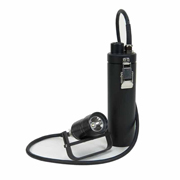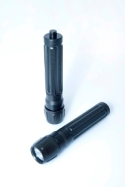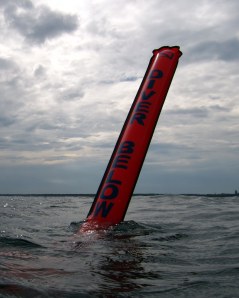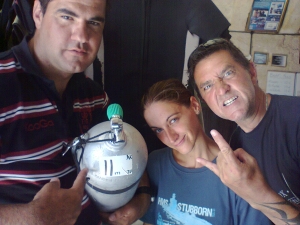Oxygen Toxicity – what’s all that about then?
If you’re a nitrox (or enriched air, EANx, or whatever else you want to call it) diver you’ll have learned about oxygen toxicity during your course. A couple of simple rules are laid out as gospel truth and with them comes an (almost) certain knowledge that you’ll stay safe.As a recreational nitrox diver, you’re told to keep your PO2 below 1.4ata throughout the dive and introduced to the concept of “the pressure T”:

From that, you can cover up any one and see the formula for the other:

So… if you want to know what your PO2 is for a particular mix and depth combination:

Or, if you wanted to know the “best mix” – the mixture with the most oxygen (which is physiologically active – that is, used by the body so it doesn’t have an effect on decompression times or no decompression limits) and the least inert gas (nitrogen for nitrox divers, nitrogen and/or helium for trimix divers) for a specific depth it works like this:

As a recreational nitrox diver, that’s more-or-less all you need to know. You’ll have learned about the CNS Clock when you did your nitrox course… but you’ll have learned – either in the course or by experience – that as a recreational diver it’s pretty difficult to approach any of those limits if you follow the 1.4ata rule.
As a technical diver, things are a bit different.
The first main difference is that we don’t always stick to 1.4ata as a PO2 limit. For the bottom portion of the dive we usually do (though some agencies teach a limit of 1.5ata, reduced by 0.05 for each “stressor” – e.g. cold or adverse weather, which brings us UK divers back to the 1.4 anyway), but for decompression we extend that limit to 1.6ata.I’ll explain, next week, a bit about why that’s the case – and why it’s considered safe to do so – but thought a bit of a recap/explanation of oxygen toxicity was a good place to start (and it followed on nicely from last night’s DSAT Tec 40 lectures!). So, here comes the science bit:
The discovery of oxygen toxicity
All the way back in 1878 a French man named Paul Bert published a book called La pression barometrique, in which he took a scientific approach to studying the way animals react to increased pressures. It’s pretty grim reading; dogs convulsing for 24 hours before finally dying, for example – but it fundamentally turned biology (and specifically our understanding of respiration) on its head. Until Bert, we’d thought respiration happened as a process of combustion – burning, in simple terms. By increasing the amount of oxygen – more specifically, by increasing the PO2, which can happen by increasing either FO2 or P – it was thought that this “combustion” in the lungs would accelerate and in doing so effectively burn away the lungs… leading to death. Bad news if you’re the test subject!Bert researched (two other French researchers named Regnault and Reiset had speculated) the premise that this isn’t the case at all. He discovered (and most importantly proved) that the effect of that increased pressure was due not to the pressure, but to the “tension at which oxygen is maintained in the various atmospheres” (Lorrain Smith, 1899). In doing so, he discovered the principle which you learned in your nitrox diver course – that keeping your PO2 within set limits is the way to dive safety.
He also began to have a good hard think about why that might be the case. If the theory of combustion was right, then convulsions were hard to explain. Physical damage to the lungs was expected – and post-mortem examinations of the test animals failed to show any such damage. The final nail in the coffin as far as the combustion theory, for Bert, was a point of common sense – if an increase in oxygen results in an increase in combustion, then the diver should get hotter. This didn’t happen; Bert was convinced there had to be another explanation.
Oxygen as a toxin
If combustion didn’t explain the deaths he was getting so adept at causing, then something else must.. and the symptoms of convulsions (identical in appearance to grand mal epileptic seizures) were very similar to those associated with poisoning or tetanus – and it’s that fact that led him to suspect that oxygen must be acting as an “agent toxic to the nervous system”. More grisly experiments later (taking blood from an animal already convulsing and injecting that blood into a healthy animal!) and he’d come to a second conclusion that we still base our understanding on today: oxygen doesn’t produce “a toxin” in the way other chemicals do (some anti-cancer drugs, for example, are broken down in the liver and produce a toxic byproduct, which is then carried in the blood – giving that blood to another person would also transfer the toxins) but acts directly on the nerves.And thus was born the theory of oxygen toxicity: Oxygen, in too high a “tension” (PO2) acts directly on nervous tissues in the same way as certain toxins. It can cause symptoms including visual disturbances, ear disturbances, nausea, twitching, irritability and dizziness (VENTID) but most commonly the symptom we see first is convulsions as the nervous system is simply unable to repair itself at a sufficient rate.
Pulmonary Oxygen Toxicity
Lorrain Smith, in 1899, realised that if Bert’s work was correct it was hugely unlikely (or, in science speak, “a priori improbable” – doesn’t that sound fancy?!) that this toxic action of oxygen would affect only the nerves. In particular, he felt that the lungs would almost certainly suffer some form of effect – an idea backed up by the fact that medical science had, by now, learned that putting people on 100% oxygen (at normal atmospheric pressure) and then leaving them there for a while had a tendency to cause pneumonia and then death. Something had to be happening in the lungs.Some more grisly experiments followed (mostly on mice this time) which showed that the effect wasn’t caused by oxygen encouraging bacterial or microbial growth (bugs!) in the lungs. Instead, the lungs were filled with a solution which appeared to have seeped out of the cells forming the walls of the alveoli themselves – a solution which caused inflammation, the closing of air passageways, respiratory distress and (again) death.
What Lorrain Smith had discovered came to be known as pulmonary oxygen toxicity, and is quite different from the CNS toxicity Bert discovered. In effect the person (or animal) drowns slowly as the lungs fill themselves with liquid. It acts slowly, over a period of several hours, and occurs at relatively low (0.6ata or higher) PO2s – high PO2s do cause it too, but the CNS effects manifest sooner and mask it.
Even for technical divers, Pulmonary Oxygen Toxicity isn’t generally considered too high a risk (though we’ll talk about tracking Oxygen Tolerance Units, OTUs) in a later post.
The body’s natural defences
What Bert didn’t know at the time was a whole bunch of science about how the nervous system works, the chemicals involved in its function, and the way it handles damage. Since then, science has come a long way. We now understand the breakdown of oxygen into water (by mixing with hydrogen in a process chemists call a reduction reaction, to form H2O) in much more detail than Bert did.During oxygen’s breakdown (from O2 to O, in order to bond with an H2) free radicals are produced. You’ll have neared these mentioned in adverts for everything from moisturiser to shampoo and green tea; the process of breaking down oxygen happens in every cell (other than red blood cells) in the human body and free radicals affect every part of us.
Al is a free radical
“Free radicals” is, in essence, a fancy name for a molecule which has a bit missing and really, really wants to fill that gap – so it wanders off and rips bits off other molecules in order to do so. Imagine being at TGI Friday’s with a group of friends and ordering food… and then Al turns up. You’re going to lose food, whether you like it or not.As those free radicals are produced, defensive enzymes in the body (an enzyme is a special chemical which makes a reaction happen faster or more easily, and so encourages things to happen that might otherwise not – in this case, the conversion of free radicals to “normal” molecules) fight the damage. Using our Al analogy, that’s seeing him come in the door and ordering another portion of boneless wings so that when he nicks half of the first lot you still have enough. The enzymes have fancy names like superoxide dismutases and peroxidases, and they’re helped out by antioxidants (green tea and red wine!) but you can think of them as the bar staff and waiters/waitresses; two teams that work together doing slightly different jobs to achieve the same goal (making sure you’re left full and satisfied even after Al’s stolen most of your hot sauce and left you with a plate full of celery).
Too much of a good thing
The body’s normal repair, building and maintenance processes repair the damage free radicals cause. They’re a natural part of breathing, eating and moving, so it makes sense that they body would be able to cope with some of them. There’s only so much the repair mechanisms can do, however – no matter how fast you order those wings, if there are three Al’s you’re in trouble.Oxygen toxicity in a nutshell
In a nutshell, then, you can view oxygen toxicity like this:
–
About the author: Kevin is a PADI Master Instructor, DSAT Tec Trimix Instructor, TDI Advanced Trimix Instructor, IANTD Instructor Trainer and IART CCR Instructor. He’s been diving professionally for more than a decade and has been fortunate enough to dive in many of the world’s most famous technical dive destinations.














